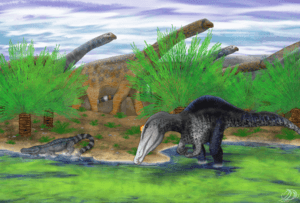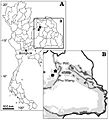Siamosaurus facts for kids
Quick facts for kids Siamosaurus |
|
|---|---|
 |
|
| Life restoration (right) with the sauropod dinosaurs Phuwiangosaurus in the background and the crocodyliform Sunosuchus in the middle left. | |
| Scientific classification |
|
| Kingdom: | Animalia |
| Phylum: | Chordata |
| Clade: | Dinosauria |
| Clade: | Saurischia |
| Clade: | Theropoda |
| Family: | †Spinosauridae |
| Subfamily: | †Spinosaurinae |
| Genus: | †Siamosaurus Buffetaut & Ingavat, 1986 |
| Species | |
|
|
Siamosaurus (say "Sye-ah-mo-SAWR-us") means 'Siamese lizard'. It was a meat-eating theropod dinosaur that lived in what is now Thailand during the Early Cretaceous period. This was about 130 million years ago!
Scientists only know about Siamosaurus from its fossil teeth. Because of this, they don't know exactly how big it was. However, they think it might have grown up to 9.1 meters (30 feet) long. The teeth found look a lot like those of another famous dinosaur, Spinosaurus. This suggests that Siamosaurus probably ate fish.
What We Know from Fossils
Scientists discovered the first Siamosaurus fossils in Thailand. These fossils were mostly just teeth. Even though we only have teeth, they tell us a lot about this ancient creature. The teeth are long and cone-shaped, which is perfect for catching slippery fish.
How Siamosaurus Lived
In 2010, a group of scientists studied the teeth of Siamosaurus and other dinosaurs like Baryonyx, Irritator, and Spinosaurus. These dinosaurs all belong to a group called spinosaurids. The study showed that spinosaurids likely lived a semiaquatic lifestyle. This means they spent part of their lives in water and part on land.
Think of animals today like hippos, crocodiles, or turtles. Spinosaurids probably lived in similar habitats, close to rivers or lakes. Living this way helped them find food without competing with other large meat-eating dinosaurs that lived only on land. They could hunt fish in the water while other predators hunted on land.
Images for kids
-
Illustration of caudal (tail) vertebrae of "Phuwiang spinosaurid B" from the Sao Khua Formation, whose remains are potentially attributable to S. suteethorni
-
Diagram comparing the holotype tooth (first from left) with other spinosaurid teeth from Asia
-
Spinosaurid teeth are often mistaken for those of plesiosaurs (above) and vice versa, though there are certain differences between their dentition.
-
Restoration of Ichthyovenator, a spinosaurine from what is now Laos and one of the closest known relatives of Siamosaurus.
-
Speculative life restoration of Siamosaurus (right) in the Sao Khua Formation environment, with the goniopholidid Sunosuchus (middle left) and a herd of the sauropods Phuwiangosaurus in the background
-
Restoration of a generic spinosaur feeding on a sauropod carcass in the Sao Khua Formation environment, a behavior hypothesized based on teeth belonging to Siamosaurus. The ornithomimosaurs in the background are Kinnareemimus.
See also
 In Spanish: Siamosaurus suteethorni para niños
In Spanish: Siamosaurus suteethorni para niños











